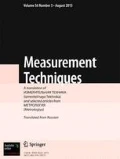Evaluation of the state of a system for ensuring the uniformity of measurements is urgent and is necessary for monitoring and state forecasting. An approach is presented for the development of a methodology for monitoring and forecasting the state of a system for ensuring the uniformity of measurements, ensuring that the mutual effect of subsystems on each other is taken into account. The approach is based on the method of hierarchy analysis. The decomposition of a system for ensuring the uniformity of measurements is examined for later processing of a sequence of judgments of a person (group of persons) making a decision. The judgments are based on paired comparisons of the elements of decomposition. The procedure of processing the judgments of a group of experts for the purpose of deriving a generalized judgment by paired comparisons is described. The results obtained can be applied for state monitoring of a system for ensuring the uniformity of measurements and forecasting the measurement requirements of the economy and society.




Similar content being viewed by others
References
M. G. Sukharev, Forecasting Methods: Textbook, RGU Nefti i Gaza, Moscow (2009).
L. A. Trofimova and V. V. Trofimov, Methods of Making Management Decisions, Yurait, Moscow (2014).
P. V. Terelyanskii, Nonparametric Expert analysis of Objects of Complex Design, Dashkov i Ko, Moscow (2009).
T. Saaty and K. Kearns, Analytical Planning. Organization of Systems [Russian translation], Radio i Svyaz, Moscow (1991).
I. V. Krasavin, A. V. Yashin, and A. K. Tulekbaeva, IOP Conf. Ser. Mater. Sci.Eng., Workshop on Materials and Engineering in Aeronautics (MEA 2020), Oct. 16–17, 2020, Moscow, Russia (2020), Vol. 1027, https://doi.org/https://doi.org/10.1088/1757-899X/1027/1/012014.
S. Bryant and J. Kearns, Pub. Admin. Rev., 42, No. 2, 144–150 (1982), https://doi.org/https://doi.org/10.2307/975536.
T. L. Saaty and K. Peniwati, Group Decision Making, RWS Publ., Pittsburgh (2008).
T. Saaty, Decision-Making with Dependences and Feedback: Analytical Networks [Russian translation], LKI, Moscow (2008).
T. L. Saaty and L. Thomas, “Relative measurement and its generalization in decision making: why pairwise comparisons are central in mathematics for the measurement of intangible factors) the analytic hierarchy/network process,” Rev. Royal Span. Acad. Sci. RACSAM, Ser. A, Math., 102, No. 2, 251–318 (2008).
I. V. Krasavin, “Methodology of the development of the concept of construction of a system for metrological provision of the Armed Forces of the Russian Federation,” in Proc. 40th Sci. Techn. Conf. of Young Scientists-Military Metrologists, Topical Issues of Military Metrology, GNMTs of the Ministry of Defence of Russia, Mytishchi (2015).
Author information
Authors and Affiliations
Corresponding author
Additional information
Translated from Izmeritel’naya Tekhnika, No. 9, pp.10–15, September, 2021.
Rights and permissions
About this article
Cite this article
Krasavin, I.V., Yashin, A.V. Evaluating the State of a Complex Ergatic System Using the Example of a System for Ensuring the Uniformity of Measurements. Meas Tech 64, 697–702 (2021). https://doi.org/10.1007/s11018-022-01991-z
Received:
Accepted:
Published:
Issue Date:
DOI: https://doi.org/10.1007/s11018-022-01991-z




